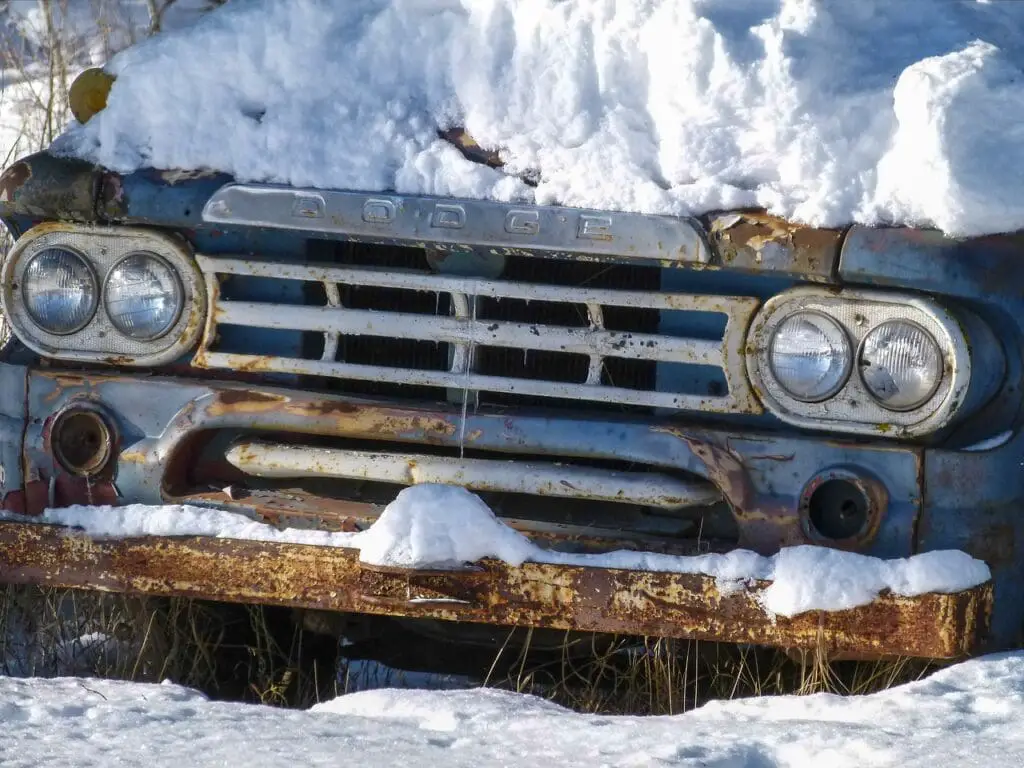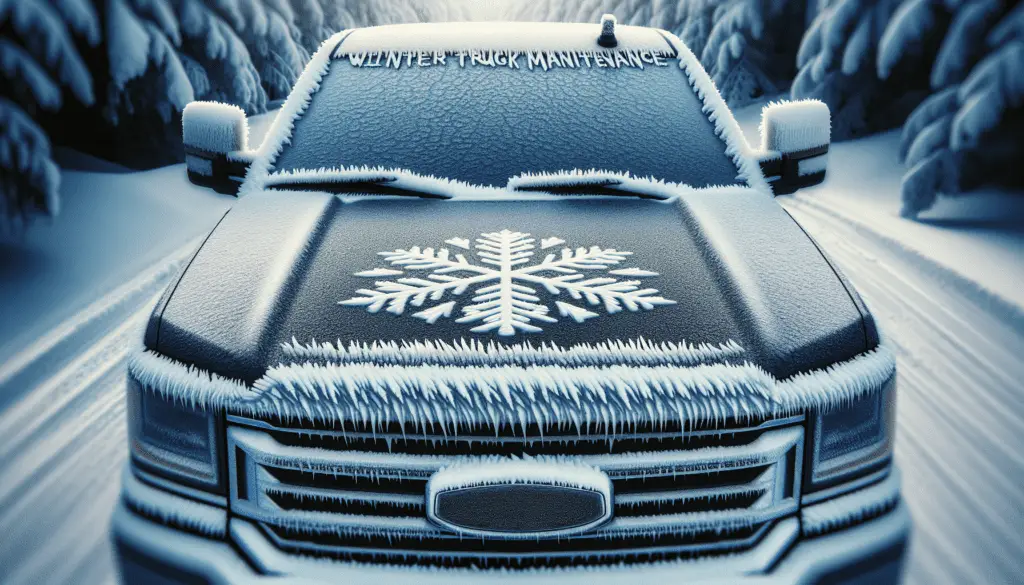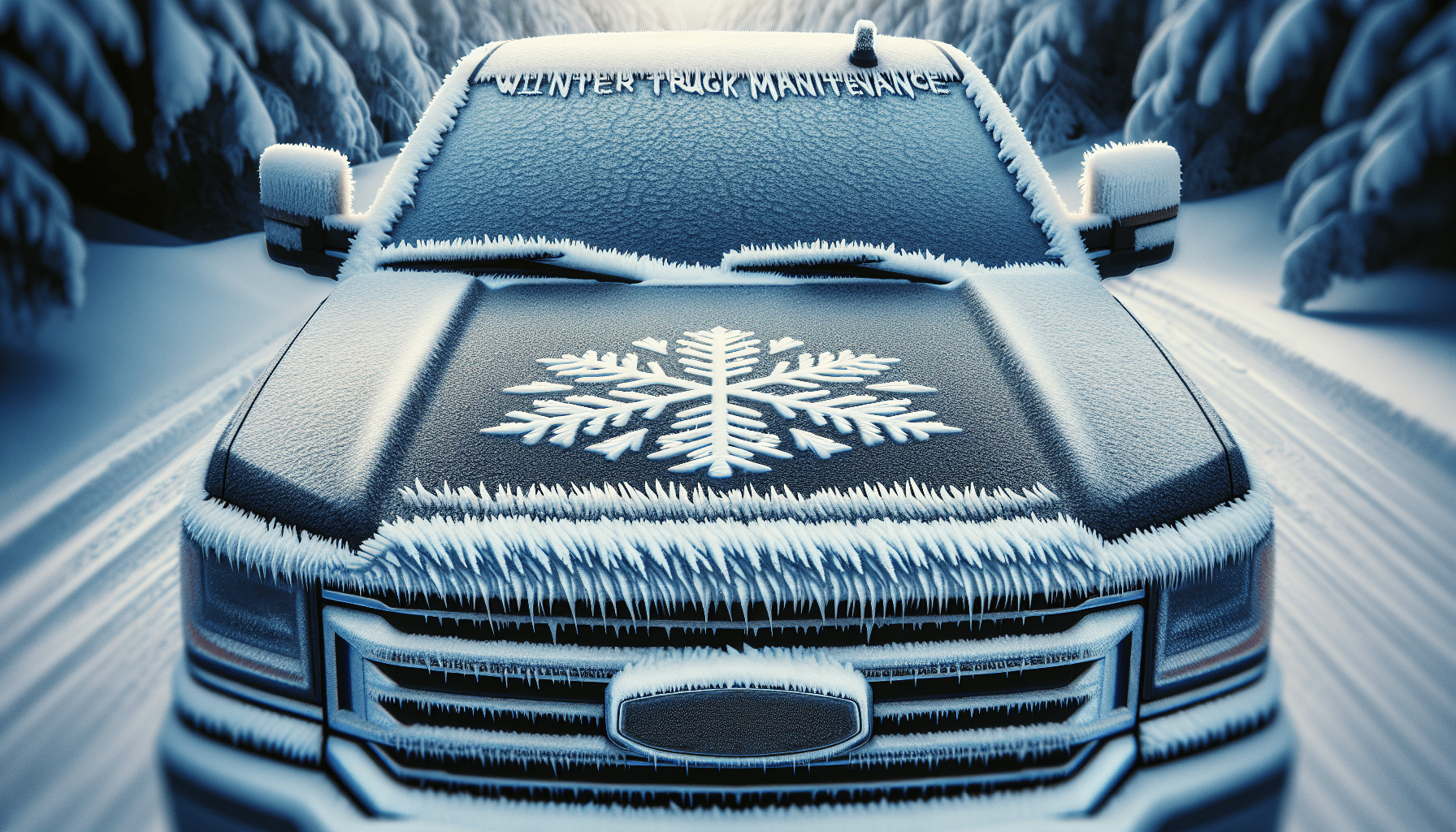The cold weather is approaching and it’s time to prepare your Ford truck for the winter months ahead. From protecting your engine to ensuring your tires are up to the task, this article will guide you through the essential steps to winterize your Ford truck. By following these simple yet effective tips, you can make sure your truck is ready to conquer the icy roads and freezing temperatures that lie ahead. So let’s get started on keeping your Ford truck running smoothly and safely throughout the winter season.

Inspect Your Truck’s Battery
When winter arrives, it’s crucial to prepare your truck for the cold weather and ensure it will start reliably. To begin, inspect your truck’s battery. Check the battery’s age and condition to determine if it needs to be replaced. As batteries age, their ability to hold a charge diminishes, and they may struggle to provide sufficient power in colder temperatures. If you notice any signs of corrosion on the battery terminals, it’s essential to clean them to maintain a good electrical connection. A mixture of baking soda and water can be used to clean the terminals, followed by a thorough rinse with clean water. If you’re unsure about the condition of your battery, consider having it tested by a professional. They can assess its strength and let you know if a replacement is necessary. Lastly, you might want to consider using a battery blanket to keep your battery warm during extremely cold weather. This can help prolong its lifespan and ensure optimal performance throughout the winter months.
Check and Replace Fluids
Proper fluid levels and conditions are vital for your truck’s performance, especially during the winter season. Start by inspecting the engine coolant level and condition. Ensure that it is at the appropriate level and that the coolant mixture is suitable for freezing temperatures. If necessary, add coolant to reach the recommended level, and consider flushing and replacing the coolant if it hasn’t been done for a while.
Next, it’s essential to change the engine oil and oil filter. Cold temperatures can cause the oil to thicken, making it less effective at lubricating the engine. By using winter-grade oil, specifically designed for colder climates, you can ensure optimal engine performance. Additionally, inspect the transmission fluid level and condition. Transmission fluid is responsible for lubricating moving parts within the transmission, and low or dirty fluid can lead to poor shifting and potential damage to the transmission. If needed, top up the fluid or consider having it flushed and replaced by a professional.
Don’t forget to inspect and fill the windshield washer fluid reservoir. During the winter, it’s crucial to have a washer fluid that is rated for freezing temperatures. This ensures that your windshield remains clear and visibility is maintained. Lastly, check the brake fluid level. Brake fluid is essential for the proper functioning of your truck’s braking system. If the level is low, it can indicate a leak or worn brake pads and should be addressed promptly.
Inspect Tires and Wheels
Your tires are the only point of contact between your truck and the road, making them vital for safe winter driving. Begin by checking the tire pressure and adjusting it as necessary. As the temperature drops, tire pressure tends to decrease, so it’s important to ensure it is at the recommended level to maximize traction and fuel efficiency. Additionally, inspect the tire tread depth. Adequate tread depth is crucial for maintaining traction on slippery winter roads. If your tires are worn and the tread depth is below the recommended level, it’s time to consider replacing them.
Winter tires are specifically designed to provide better traction, handling, and stopping power in cold weather conditions. If you live in an area with significant snowfall or icy roads during the winter, it’s highly recommended to invest in a set of winter tires. They can greatly enhance your truck’s performance and safety during winter driving.
Inspecting and tightening wheel nuts is another important step. Loose wheel nuts can lead to wheel wobbling or even detachment, posing a significant safety risk. Take a few moments to ensure all wheel nuts are securely tightened to the manufacturer’s recommended torque specifications. Lastly, carefully inspect your tires and wheels for any signs of damage. Look for cuts, bulges, or nails embedded in the rubber. If you notice any issues, consider having them repaired or replaced as necessary to avoid potential tire failure during winter driving.
Replace Wiper Blades
Maintaining good visibility is crucial during winter driving, and having functional wiper blades is essential. Inspect your wiper blades for any signs of damage, such as cracks, tears, or a worn-out rubber edge. If the blades show any signs of wear, it’s best to replace them. Worn or damaged wiper blades can hamper your visibility during rain, snow, or sleet, making driving hazardous.
Consider using winter-specific wiper blades that are specially designed to handle snow and ice. These blades feature a rugged construction and a protective rubber boot to prevent ice and snow buildup, ensuring optimal performance in harsh winter conditions. It’s also important to ensure proper windshield washer fluid coverage to effectively clean the windshield. Use a winter-grade washer fluid that is less likely to freeze and can handle the road grime and salt buildup commonly encountered during winter driving.

Check and Maintain Heating System
A reliable heating system is essential for staying warm and comfortable while driving during the winter months. To ensure optimal performance, it’s important to inspect the heating system for any leaks or issues. Check for any coolant leaks under the dashboard or in the engine compartment, as these can impact the heating system’s ability to function properly. If you notice any leaks, it’s best to have them repaired promptly.
Additionally, check and replace the cabin air filter if needed. The cabin air filter is responsible for filtering the air that enters the interior of your truck. Over time, it can become clogged with debris, reducing airflow and potentially impacting the heating system’s performance. If the filter appears dirty or hasn’t been replaced for a while, it’s advisable to install a new one.
Finally, test the heater and defroster to ensure they’re operating correctly. A properly functioning heater will keep you warm during your drive, while a functioning defroster is essential for clearing foggy or frost-covered windows. If you notice any issues with the heater or defroster, have them inspected and repaired by a professional.
Prepare Your Truck’s Exterior
Winter weather, with its snow, ice, and road salt, can take a toll on your truck’s exterior. To protect the paint and maintain its appearance, it’s important to wash and wax your truck before the winter season. A thorough wash will remove any dirt and grime that can contribute to paint damage, while a coat of wax provides an extra layer of protection against the elements. Be sure to pay attention to areas such as the grille, wheel wells, and the lower portions of the body, where salt and moisture tend to accumulate.
In addition to washing and waxing, consider applying a protective coating to the undercarriage of your truck. This will help shield crucial components such as the frame, suspension, and exhaust system from road salt and corrosion. There are various undercarriage sealants and coatings available that provide long-lasting protection.
Don’t forget to clean and treat rubber seals and weather stripping. Freezing temperatures can cause rubber to become brittle and crack, leading to air and water leaks. By using a silicone-based rubber protectant, you can keep the seals and weather stripping pliable and prevent costly damage. Lastly, if you have access to a garage or covered parking, consider using a car cover to provide additional protection against the elements. A car cover can help shield your truck from snow, ice, and other winter hazards that could potentially damage the exterior.

Inspect and Maintain Lights
Properly functioning lights are essential for safety during winter driving, as daylight hours are shorter and visibility can be reduced. Start by checking the headlights, taillights, and turn signals. Ensure that all bulbs are working and that their lenses are clean and free from any dirt or snow buildup. If you notice any burnt-out bulbs, replace them promptly to maintain optimal visibility on the road.
Additionally, it’s important to clean and adjust the headlights for optimal performance. The buildup of snow, ice, and road grime can affect the brightness and direction of the headlights. Regularly clean the headlight lenses using a lens cleaner or a mild soap and water solution, ensuring they are clear and free from any haze or discoloration. If necessary, adjust the headlight aim to ensure they are properly aligned and provide the best illumination while driving at night.
Prepare an Emergency Kit
Winter driving can be unpredictable, and it’s essential to be prepared for unexpected situations. Assemble an emergency kit that includes essential items to keep you safe and comfortable. Start with a first aid kit that contains basic medical supplies, such as adhesive bandages, gauze, and antiseptic wipes. A reliable flashlight, with extra batteries, is also crucial for visibility during emergencies.
Pack supplies such as jumper cables, a snow shovel, and tire chains in case you encounter challenging road conditions or get stuck in the snow. These items can help you get your truck moving or assist others in need. Additionally, include a fully charged portable phone charger in your emergency kit to ensure you can always communicate and request assistance if needed.
Lastly, don’t forget to add non-perishable snacks and water bottles to your emergency kit. In case you’re stranded for an extended period, having food and water available can make a significant difference in your comfort and well-being.
Protect Your Truck’s Interior
While much of winter preparation focuses on the exterior of your truck, it’s equally important to protect the interior from the elements. Start by thoroughly cleaning and vacuuming the interior. Remove any dirt, debris, or salt that may have accumulated and could potentially cause damage over time. Pay particular attention to the floor mats and carpeting, as these areas often come into contact with moisture and road salt. Using floor mats can help protect the carpeting and make it easier to clean.
To further protect the seats, apply a leather or fabric protectant. These products help create a barrier against stains, spills, and general wear and tear. They also facilitate easier cleaning and prolong the life of the upholstery.
Consider using seat covers for added protection. Seat covers not only provide an extra layer of defense against spills and stains but also offer increased comfort and customization options.
Plan for Regular Maintenance
Regular maintenance is critical for ensuring your truck’s optimal performance and longevity. To stay on top of maintenance tasks, follow the manufacturer’s guidelines for maintenance intervals. These guidelines outline when various components and systems should be inspected, serviced, or replaced.
It’s also beneficial to schedule a pre-winter maintenance check-up with a professional. A qualified technician can thoroughly inspect your truck, identify any potential issues, and address them before they become more significant problems during the winter season.
Finally, keep track of maintenance records and document any issues that arise. This not only helps you stay organized but also provides valuable information for future reference. Having a maintenance history can be beneficial when selling your truck or if warranty claims are necessary.
By following these comprehensive steps on how to winterize your Ford truck, you can ensure that it is well-prepared for the challenges of the winter season. Taking the time to inspect and maintain essential components, protect both the exterior and interior, and plan for regular maintenance will help keep your truck running smoothly and safely throughout the colder months. Stay warm, stay safe, and enjoy the winter with confidence knowing that your Ford truck is ready for whatever Mother Nature has in store.


